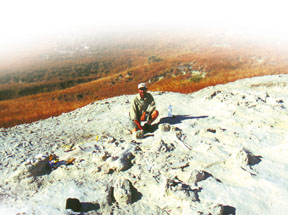
Geotimes Home | AGI Home | Information Services | Geoscience Education | Public Policy | Programs | Publications | Careers


“This tooth is to existing models as a square peg is to a round hole,” says Richard Cifelli, curator of vertebrate paleontology at the Sam Noble Oklahoma Museum of Natural History who hails the discovery as analogous to the finding of the Burgess Shale.
Most mammal fossils from the Late Cretaceous have been found in northern continents. This has led to a dominant theory that marsupials and placental mammals arose in the Northern Hemisphere and over time displaced archaic groups of mammals living on the southern continents that made up Gondwana, such as South America and Australia. The timing of this takeover hinges on the connection between North America and South America. But evidence shows that, during the Late Cretaceous, a 500-kilometer ocean barrier separated them. The tooth may imply either a connection between the continents during the Mesozoic or a southern origin for marsupial mammals.
In 1993, David Krause, a paleontologist at the State University of New York at Stony Brook, decided to look for Mesozoic mammals in the Southern Hemisphere. It was a gamble. Only a handful of specimens from extinct mammal groups had been found in the south and most of those came from South America.
“We didn’t know what to expect,” Krause says. His team worked for six weeks at a time during the summers in the semiarid Mahajanga Basin of northwest Madagascar. Over the course of six expeditions to the island continent, he and his team have found seven mammal teeth — the first one within 20 minutes of the first dig. Two of the teeth belong to a new mammal species, which the team assigned to a group called gondwanatheres.
The marsupial tooth came in two pieces, each less than a few millimeters long. The first section of the molar was identified in 1998 and continued searching of the collected matrix turned up its counterpart a year later. Krause believes this tooth implies that modern placental mammals on Madagascar, such as the lemurs, arrived after Madagascar became an island, about 88 million years ago — after marsupials were already broadly distributed on Gondwana.
“What was impressive to me was that it suggests that North and South America were connected during the Cretaceous at some point,” says William Hay of GEOMAR Research Center for Marine Geosciences in Germany. And he thinks this might be possible, if, before the Caribbean plate picked up Cuba, it briefly connected North and South America. “We called up the plate tectonic maps to look and see if it was possible and by golly it was. To get the timing right all we have to do is change the timing of when the Caribbean plate goes through Central America.”
The tooth follows a 1999 discovery of a Jurassic mammal jaw from Madagascar that also put pressure on the current theory regarding a northern origin of mammals (see Geotimes, November 1999). “The vexing difficulty in trying to resolve the time and place of the first appearance of both the marsupial and placental mammals is that their Mesozoic fossil record on the Gondwana continents is extremely meagre,” says Tom Rich, curator of vertebrate paleontology at the Museum Victoria in Melbourne, Australia.
“It could well be that they were thriving on the Gondwana continents well before they appeared in the Northern Hemisphere but that the fossils to establish that have just not been found,” he says. “Dave’s discovery is therefore one step, and an important one, in the process of acquiring the evidence to decide one way or another whether the traditional view of a Northern Hemisphere origin for these two groups of mammals — which dates back at least to the writings of Alfred Russel Wallace in 1876 — is in fact what actually happened.”
Christina Reed
 |
Geotimes Home | AGI Home | Information Services | Geoscience Education | Public Policy | Programs | Publications | Careers |